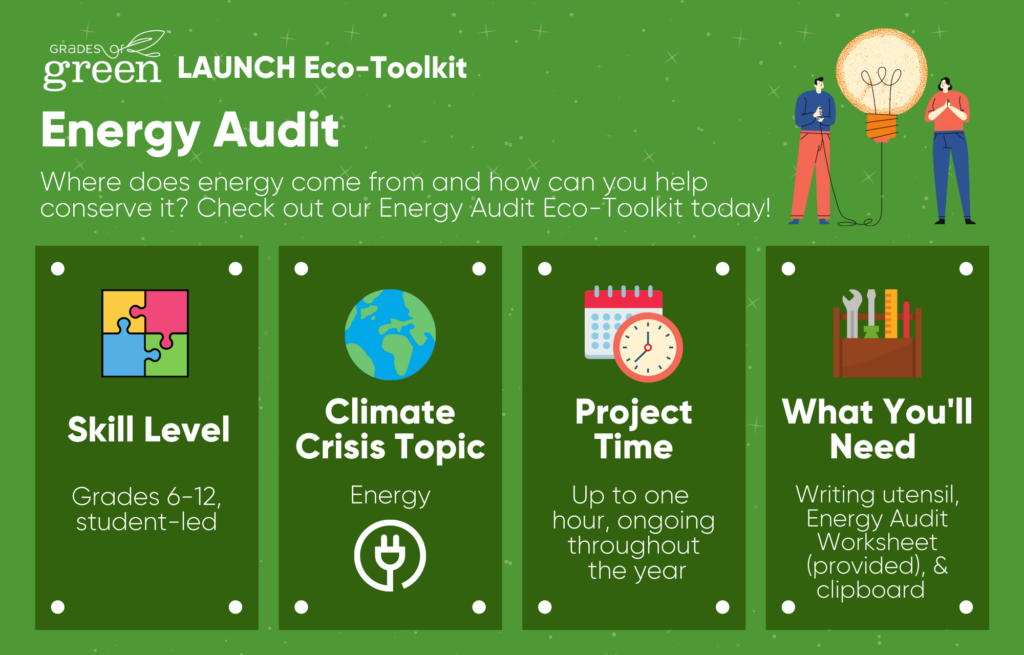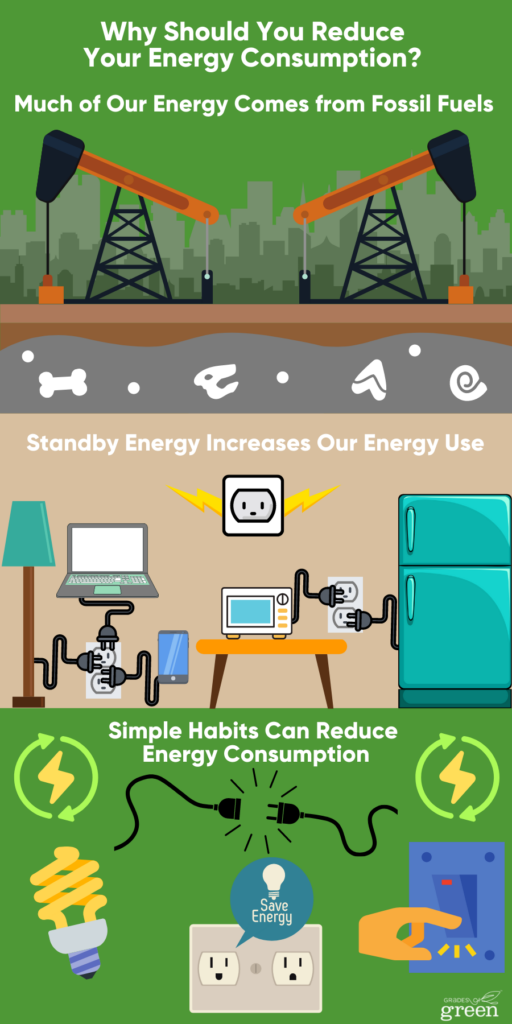Don’t standby on wasted energy! Conduct an Energy Audit!
Did you know that plugged in appliances still use electricity even when they’re turned off? These energy sucking objects are called standby appliances. By taking part in our Energy Audit Campaign, you will discover how much energy is being wasted and learn how significant of an impact energy systems have on climate change.

Toolkit Details


NGSS
This toolkit address the following Science and Engineering Practices (SEPs) within the Performance Expectations of NGSS for Grades: 6-8 and 9-12
- Asking Questions and Defining a Problem
- Planning and Carrying out Investigations
- Analyzing and Interpreting Data
- Using Mathematics and Computational Thinking
- Constructing Explanations and Designing Solutions
- Obtaining Evaluating, and Communicating Information
Learning Objectives
- Analysis
- Students will analyze a classroom/school building(s) for energy use
- Project Management
- Students will practice collection, analysis, and presentation of data
- Students will create schedules to conduct audits
- Students will exercise effective communication and accountability
- Evaluation and Assessment
- Students will track and evaluate the information they have collected
What is an Energy Audit?
An Energy Audit is an analysis of the energy consumption in your environment. This could include your home, classroom, or any other location. As a team, you will examine your desired room/location and determine which appliances require or do not require to be plugged in at all times. Despite being turned off, plugged in appliances can still draw electricity, which increases fossil fuel consumption of energy use.
What You Will Accomplish
Recognize areas in the classroom/home where changes can be made to be more energy efficient. By conserving energy, you will:
- Reduce the amount of fossil fuels burned
- Increase the amount of energy available to others. This would allow individuals to complete more tasks
- Save energy
- Save money on your electric bill
- Become more aware of your energy-use habits and discover much energy goes to waste each day
- Develop gratitude for reducing the amount of energy used by humans
Why Should You Reduce Your Energy Consumption?
The resources provided can be shown as a slideshow or printed out as individual worksheets for students to learn.

Much of Our Energy Comes from Fossil Fuels
Although many countries are investing more and more into renewable energy sources, such as solar and wind, much of the energy that we use throughout the world still comes from fossil fuels. Coal, crude oil, and natural gas are all considered fossil fuels because they were formed from the fossilized, buried remains of plants and animals that lived millions of years ago. Because of their origins, fossil fuels have a high carbon content. Today, oil, coal, and gas provide roughly 80% of our energy needs. Extracting and burning fossil fuels releases chemicals and greenhouse gasses into the atmosphere, which causes air pollution and increased global temperatures. [1]
Standby Energy
Many appliances leech energy even when they are shut off; this is called standby energy and can account for 20% of a household’s energy bill every month. Every cord that remains plugged into an outlet is pulling energy out. While many of them have “standby mode,” they still continuously use electricity to perform updates, connect to remotes, and record data. Some of the most common appliances that “leak” energy are computers, printers, satellite and cable boxes, stereos, TVs, microwaves, garage door openers, and video game consoles. [2]
Simple Habits Can Reduce Energy Consumption
It’s easy to save energy and thereby reduce pollution from fossil fuels. Some notable changes include:
- Unplugging appliances that are not in use
- Using power strips that can be turned off at night
- Replacing incandescent light bulbs with LED light bulbs
- Install motion activated light switches
Why Energy is an Environmental Justice Issue
Using energy relates to environmental justice due to our reliance on fossil fuel consumption. The production, use, and extraction of fossil fuels have numerous consequences on the environment they occupy. Areas where fossil fuels are extracted and processed are called “sacrifice” zones because the health and well-being of the local people and the environment are sacrificed in order to access the fuel. The residents that occupy “sacrifice” zones are often people of color, and the decision to sacrifice the area is most often made by people who do not live in or near the area.
Watch these two short videos to learn why it’s important to reduce energy consumption!
Think About It!
Pre-Activity Questions
- What are some appliances or things in your house/classroom that are plugged in even if they’re not being used?
- What do you think uses the most energy out of these appliances?
- What is the difference between different energy types such as renewable or non-renewable sources? Which type has a higher negative environmental impact?
Take Action: How to LAUNCH an Energy Audit
Follow the steps below to set up a successful Energy Audit at your school! Need help? Contact us!
Step 1: Decide Who’s Participating
Use this Energy Audit Sign-Up Sheet to invite fellow classmates to participate in your campaign.
- 1 – 4 students – plan to conduct an Energy Audit in your classroom once a week or once a month.
- Multiple teams – have each team conduct an Energy Audit on different days of the week. Use our Energy Audit Monitoring Schedule to organize a schedule.
- School – Have each classroom conduct an Energy Audit on a daily basis.
Creating team names is a fun way to get creative! Encourage energy-themed team names and collaborate with others.
Step 2: Choose the location of your Energy Audit
Conducting a successful Energy Audit will likely lead you to select a location that is indoors. The easiest place to analyze would be your classroom; however, get creative and pick places such as your school library, administrator’s office, or your own home!
Step 3: Get Permission
Before you start your Energy Audit, ask for the necessary permissions (from a teacher, principal, or any other staff) to analyze your room of choice.
Step 4: Gather Your Materials
Gather the following materials and determine a safe place to store them when not in use:
- Writing utensil
- Clipboard
- Energy Audit Worksheet
Step 5: The Pre-Audit
Before you conduct your scheduled Energy Audits, you must first determine how energy is currently being used in your reviewed location. Using the Energy Audit Pre-Project Analysis, make note of what appliances are being used in addition to how many plugs/outlets are being used.
Step 6: Begin Your Audit
1. Assign Roles
Determine who and how many students are participating. Divide students into roles using the Energy Audit Team Organizer.
- Walk Through Lead: Student will lead the team throughout the room and note sources of energy use.
- Notetaker: Student completed the Energy Audit Worksheet.
- Appliance Watch: Student will keep track of any new appliances introduced throughout the week/month/school year.
- Floater (teams of 4 or more): Assists other roles and reviews Energy Audit Worksheet accuracy before daily* team transfers.
*Note: Frequency of transfer depends on how often you conduct Energy Audits.
2. Create a Monitoring Schedule
Use the Energy Audit Monitoring Schedule to organize specific times for individuals/teams to conduct Energy Audits. When you are organizing the schedule, consider the following:
- How many audits will be held?
- Which team/individual will conduct the audit?
- When will audits be held?
- Where will the audit take place? This can be specific towards a classroom or locations around campus.
3. The Energy Audit
Use the Energy Audit Worksheet to conduct your audit. Teams will walk through the room and track the number of:
- Outlets
- Powerstrips
- Appliances plugged in and on
- Appliances plugged in and off
The team will then consult with teachers/staff on what appliances can be unplugged when not in use. At the end of the audit, place the materials in the designated storage area.
- Students with the “Appliance Watch” role will monitor any new appliances that come into the classroom and take note of them on the Energy Audit Worksheet.
- The working team will then meet with the next through each cycle to discuss any updates.
Reflection Questions
How’d It Go?
- What were some small wins that happened during your project?
- What could you do to up your game next time?
- What personal changes will you make to reduce your energy consumption?
Report Your Students’ Impact
Congratulations!! You’ve implemented your Energy Audit! Don’t let all that hard work go unnoticed. Submit your results by clicking the green button below.
Project ongoing? No problem! Let us know what you’ve done so far.
By reporting your impact, Grades of Green can:
- CELEBRATE and elevate your students’ hard work and success.
- Offer our programs FREE for all students across the globe.
- AWARD stipends and certificates to hard-working educators and students.
Please take a few minutes to submit your results. Thank you!
Provided Resources
- Energy Audit Sign-Up Sheet
- Energy Audit Team Organizer
- Energy Audit Pre-Project Analysis
- Energy Audit Monitoring Schedule
- Energy Audit Worksheet
- Energy Audit Slides
- Energy Audit Wrap Up Form
- Toolkit Resources – Google Drive Folder
Congrats on completing the Energy Audit Eco-Toolkit!
Did you enjoy this toolkit? Find your next project here!
